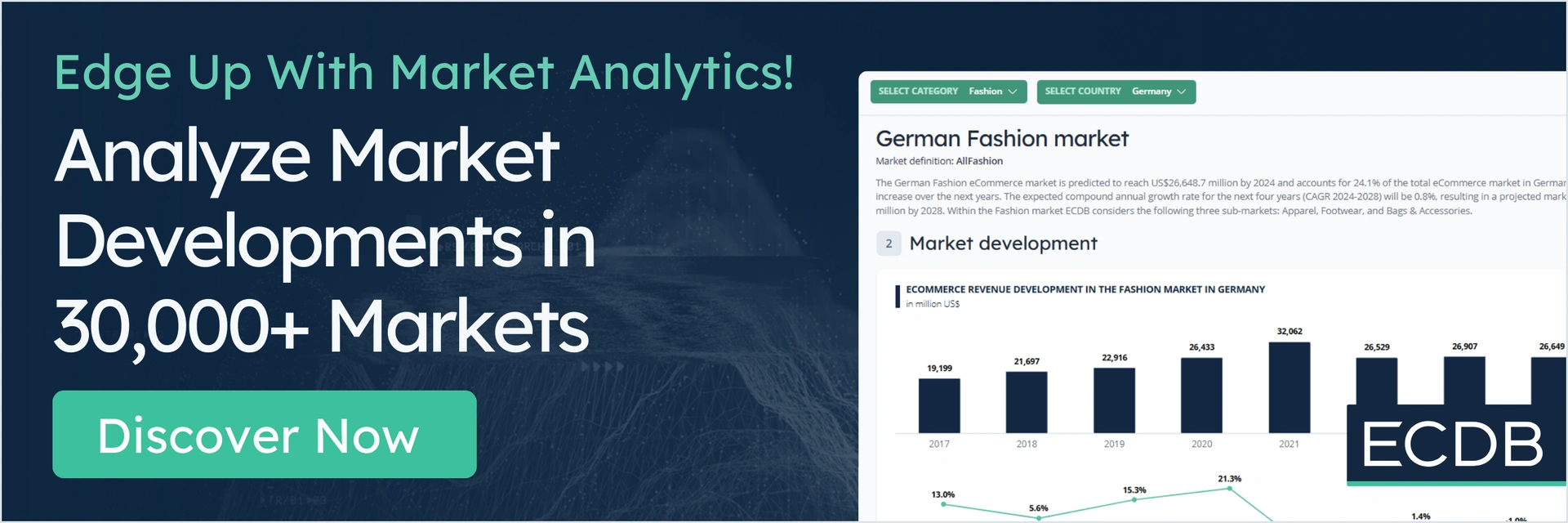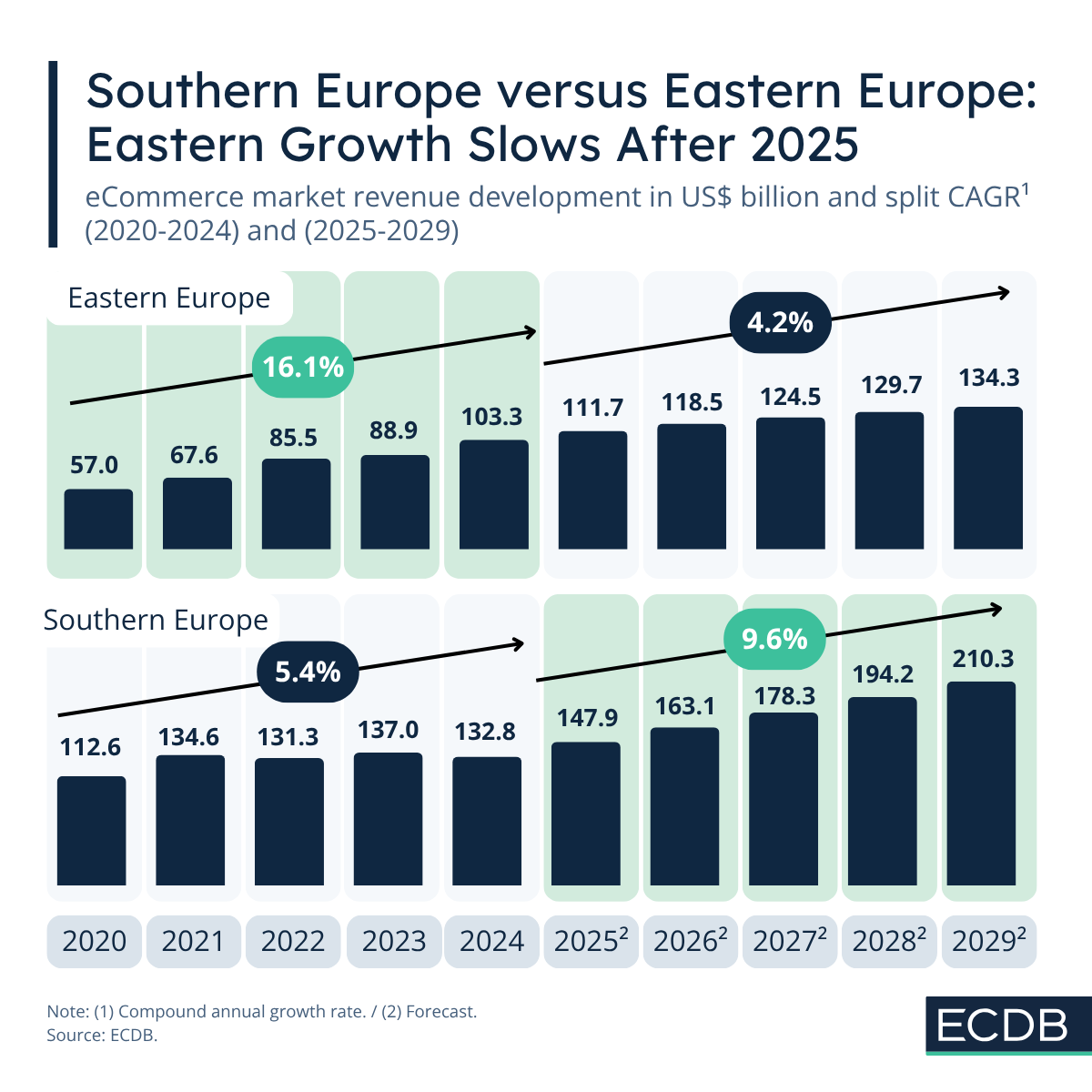Recently, ECDB reported on Southern Europe’s positive growth trajectory, which has propelled the region to the forefront of eCommerce development in Europe.
But there is another region with similar market preconditions and high growth expectations: Eastern Europe.
Let’s see which region has higher eCommerce potential now and in the future.
Similar Population Size Despite Higher Country Count in Southern Europe
First, we need to start with some statistical facts. As per ECDB definition, Eastern Europe consist of Armenia, Azerbaijan, Belarus, Bulgaria, Georgia, Moldova, Romania, Russia, and Ukraine. These are 9 countries in total.
In contrast, Southern Europe consists of Albania, Bosnia and Herzegovina, Croatia, Cyprus, Greece, Italy, Malta, Montenegro, North Macedonia, Portugal, Serbia, Slovenia, Spain, and Türkiye. In sum, there are 14 countries.
Although Southern Europe has more countries, its population size is similar to that of Eastern Europe. Eastern Europe had 237.7 million inhabitants in 2024, while Southern Europe had 238.1 million.
These stats will be considered in the following analysis to provide perspective.
Southern Europe’s Annual Per Capita Revenue Was US$558 in 2024
Eastern European eCommerce is set at a CAGR (2020-2029) of 9.0%, compared to Southern Europe’s CAGR of 8.3% over the same period. In 2024, their population counts diverged by only 400,000 people.
This results in higher eCommerce revenues per capita in Southern Europe, which generates higher eCommerce revenues than Eastern Europe. In Southern Europe, the annual per capita eCommerce revenue is US$557.9, while the per capita revenue of the average consumer in Eastern Europe is US$434.7.
This statistical fact alone accounts for Eastern Europe’s higher CAGR; regions with lower current revenue often have greater room for expansion. While this certainly plays a role, there are other factors to consider.
One of these aspects is breaking down CAGR over the ten-year period. Splitting the period of observation into post-pandemic (2020-2024) versus normalization (2025-2029), shows that Eastern Europe conquered the former where Southern Europe is expected to surge ahead in the years to come.
Eastern Europe’s Growth Has Been More Consistent Than That of Southern Europe
Over the years, Eastern Europe grew more notably and at a more consistent level than Southern Europe. The Eastern European CAGR (2020-2024) during that period was 16.1% compared to 4.2% in Southern Europe.
These immense differences stem from higher fluctuations in Southern Europe, which saw both negative rates (in 2022 and 2024) as well as highly positive ones of up to 70.1% in 2020.
Southern Europe (including Spain, Italy and Portugal) was quite severely hit by Covid, which led to a much higher increase in eCommerce offerings that weren’t there before. In Eastern Europe, the development stretched out more steadily over this time frame.
Southern Europe’s Development Takes Off After 2025
Overall, Eastern Europe’s digital development is at another stage right now. After 2025, growth approaches a lower trajectory of 5.4%, while Southern Europe accelerates with a CAGR (2025-2029) of 9.6%, despite its overall advanced maturity. Southern Europe is set at a higher revenue level and online share, and its eCommerce progression is gaining momentum in this context. Eastern Europe’s online share is at 8.4% in 2024, compared to Southern Europe’s 10.5%.
Both regions benefit from a combination of structural and behavioral factors driving their upward trajectory. They continue to expand their digital infrastructure, supported by affordable broadband and widespread smartphone access.
In Eastern Europe, local and regional marketplaces such as eMAG, Ozon, but also international ones like AliExpress and Temu have built consumer trust. A similar pattern is visible in Southern Europe, where both local (El Corte Inglés, Skroutz, Trendyol) and international players drive forward development.
Southern Europe’s Benefits Are Political and Structural
Demographic and economic factors contribute to the rapid growth of both regions. Eastern and Southern Europe have tech-savvy, bargain-seeking populations, but the Eastern European population is slightly younger. The two regions include very small countries with fewer than 10 million inhabitants, which allows for high growth due to a small baseline.
Southern Europe does have a political advantage though, as Eastern Europe is affected by the war between Russia and Ukraine, which inhibits development. In contrast, Southern Europe has more EU members, which drive digital infrastructure and regulations that promote growth.










